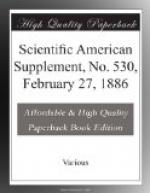Although the eosine permits a large limit in the quantity, it will reduce the sensitiveness greatly in larger quantity.
If eosine solution is mixed with bromide of silver emulsion, which is entirely free from nitrate of silver, no eosine silver can form; it acts, therefore, only as an optical sensitizer.
Of the several kinds of cyanin, chlorosulphate, nitrate, and iodide, the latter acts best, as stated by Eder.
Schumann has already said that one drop of cyanin solution, 1 to 2,500 to 61/2 c. c. emulsion, already acted as sensitizing in orange; five to ten drops cyanin. 1 to 1,500 to 15 c. c. emulsion, even gave red action.
There are two ways to color the gelatine film with a suitable coloring matter: by mixing the latter directly before filtering into the ready made emulsion, to produce at once colored plates; or to bathe dry emulsion plates for one to five minutes in a solution containing the sensitizing coloring matter. The plates have previously to be soaked for a few minutes, whereupon they are bathed in an aqueous alcoholic solution (with eosine yellow shade and eosine blue shade, in a solution of 1 to 3,000; but with cyanin in a diluted solution of 1 to 5,000). A mixture of 1/10 cyanin and 9/10 eosine yellow shade (of above concentration) acts as a very favorable sensitizer. Lohse recommended bathing of the gelatine plates in a solution of 0.03 eosine and 10 c. c. ammonia in 100 parts of water. He found that very diluted eosine solutions, 1 to 20,000, acted as a yellow sensitizer.
After washing, the plates have to be rinsed and dried—colored plates, as long as they remain moist, being less sensitive than dry ones, and very seldom the reverse.
This bathing of the ready made plates may give good results, but pure and faultless plates are very seldom obtained, wherefore the first mentioned manner (direct addition of color to the emulsion) is to be preferred.
After the experiments made by me, eosine mixtures acted equally in the yellow and blue shade; likewise mixtures of cyanin 1/10 and eosine yellow shade 9/10 were the most favorable. The process with eosine underwent first of all a thorough test, of which the following are the results.
The color, solution I made as follows:
I. 0.5 grm. eosine yellow shade in 750 c.c. alcohol (95 per cent.) is dissolved under good shaking.
II. 0.5 grm. eosine blue shade is also dissolved in 750 c.c. alcohol.
(The emulsion preparation I do not repeat, supposing that everybody is conversant with the same.)
To an emulsion after Monckhoven’s method, I add, before filtering, above eosine solutions to 1,000 c.c. emulsion, 15 c.c. each of yellow shade and 15 c.c. of blue shade eosine; mix with a glass stirring-rod, filter, and begin the flowing of the plates. On the contrary, to an emulsion made after Henderson’s method, double the quantity of coloring matter can be added before flowing, without reducing the sensitiveness perceptibly.




